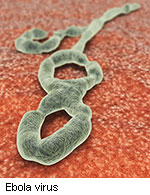Nebraska Biocontainment Unit process includes cleaning of recovered patients, disposal of remains
MONDAY, March 9, 2015 (HealthDay News) — The Nebraska Biocontainment Unit (NBU) has implemented a thorough process for decontamination after treatment of patients with potential or confirmed Ebola virus disease (EVD), according to an article published in the March 1 issue of the American Journal of Infection Control.
Katelyn C. Jelden, from the University of Nebraska Medical Center in Omaha, and colleagues detail the approach of the NBU’s patient dismissal, human remains removal process, and environmental decontamination experience to prepare other medical facilities for environmental infection control in the care of patients with EVD.
The authors emphasize the importance of appropriate personal protective equipment (PPE) use throughout dismissal and decontamination. The recovered patient may still serve as a disease vector and should be thoroughly cleaned before dismissal from the isolation unit. Patient remains are an established transmission route and should be treated accordingly, while maintaining respect and dignity for the patient. Meticulous decontamination should be performed in the entire isolation unit using appropriate procedures for treatment and removal of all waste, disinfection of nondisposable medical equipment, desiccation of virus potentially present in the environment, manual disinfection, and a terminal disinfection treatment. The decontamination process lasts almost a week from the time of patient exit until someone can enter the NBU without PPE.
“These methods may also be useful in preparing other medical facilities in environmental infection control practices in the event another highly infectious pathogen is encountered,” the authors write.
Copyright © 2015 HealthDay. All rights reserved.








